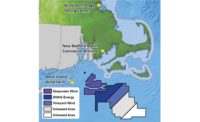On the heels of large investments earlier this month by nearby Massachusetts and Rhode Island, Connecticut has selected a proposal from developer Deepwater Wind for a 200-MW offshore wind power project as its first major move into that clean energy sector. But Maine won’t soon follow its New England neighbors, with regulators opting to revisit a previously negotiated state power purchase deal.
Connecticut Gov. Dannel Malloy (D) on June 13 announced the project, to be built between Block Island, R.I., and Martha’s Vineyard, Mass., near the other states’ facilities. Construction would begin as early as 2020, said Deepwater Wind, which also will build the 400-MW Rhode Island project and develop the first operating 30-MW U.S. offshore wind farm near Block Island. Connecticut also approved four fuel cell projects totaling 52 MW, doubling installed capacity.
Competition and bulk purchasing of clean energy in Atlantic Coast states continue to drive costs down, state officials said. The Connecticut projects will now negotiate with state electric utilities on 20-year power contracts.
But in a June 12 vote, Maine’s Public Utilities Commission moved to reopen terms of a 2014 state power contract with the University of Maine’s 12-MW Maine Aqua Ventus offshore wind project in light of current pricing trends, it said. Gov. Paul LePage (R) has been an offshore wind power critic. The vote is a setback for the project to test its patented deepwater floating turbine technology and to spur launch of a state offshore wind industry. The school remained “extremely committed” to the project, it said, noting that most offshore wind in Maine, and in 60% of the U.S., is located in deep water where only floating turbines can be used.





Post a comment to this article
Report Abusive Comment